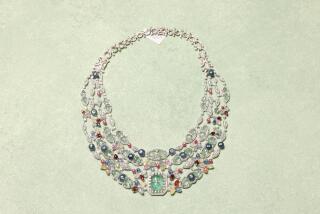Silversmith’s Mark Isn’t Critical Factor
- Share via
Question: How important are silversmith marks to the collector of American silverware?--R.T.
Answer: Since the manufacture of silverware has been going on in this country for more than three centuries, the number of different silversmith marks is too vast to be of interest to most collectors. That isn’t to say collectors shouldn’t study the marks; they should, in the context of learning about the history of the craftsmen who created this much-sought-after category of collectibles.
But, according to collectors and dealers, marks usually are not of paramount importance to the collector.
One problem has been that there hasn’t been a constant standard for American silverware marks, and so they have been difficult to catalogue over the years. For example, some smiths spelled out their names, others only used initials. To trace antique silverware, collectors oftentimes have to wear two hats--that of a historian and a detective.
Thus, it’s no surprise that in a collectible area where a spoon can cost $100 or more, value is usually linked to more than just the smith’s mark.
Instead, collectors say antique silver pieces are more often valued on the age and condition of the piece and the creativity and talent of the silversmith. Then, perhaps, the name of the silversmith will be evaluated in calculating the overall collectible price.
Like everything else, there are exceptions.
For example, a premium is placed on silverware created by the Revere family of Boston--if the mark can be authenticated by silverware experts. Paul Revere Jr. was, as any collector of silverware will tell you, the most famous American silversmith. His work, much of which has found its way into museums, commands premium prices.
Revere, who lived from 1735 to 1818, placed his mark in gold block lettering within a rectangular border, or simply left his initials--PR--in script.
Then, there are unmarked pieces of silverware that can create problems when you are attempting to trace a collection. Some museum curators and other experts try to match unmarked work with marked pieces in an attempt to identify the silversmith.
Most collectors will tell you that buying unmarked silverware is a tricky area, and the novice should be careful when not sure about a piece’s age or origin.
Of course, as in the case of most collectibles, there is the counterfeit silversmith mark to be concerned about too. As you might expect, the Revere name has a high profile and, as a result, is a favorite of counterfeiters.
Clever counterfeiters have stolen small fortunes from unwary collectors by carefully re-creating a Revere mark, collectors and dealers warn.
One trick that has been used, they say, is to fake an inscription so that it reads as if it was from the Revere family and given to some famous person of the period. But collectors say such inscriptions are rare and should raise a warning flag in a buyer’s mind.
Oftentimes, the counterfeiter will treat the mark to give it an “aged” look. As such, collectors say, it will be almost impossible for the buyer, particularly the novice, to tell if actual antique silver is being offered for sale. They say that’s when you should keep your pocketbook closed and turn to experts for advice.
Date Book
What’s being billed as the Great International Collectibles Show and Sale is scheduled for June 27 and 28 at the Glendale Civic Auditorium, 1401 N. Verdugo Road, Glendale. Admission $3; parking free.
The show will feature two floors of collectibles ranging from toys and dolls to vintage radios. For more information, call (213) 656-1266.
Ronald L. Soble cannot answer mail personally but will respond in this column to questions of general interest about collectibles. Do not telephone. Write to Your Collectibles, You section, The Times, Times Mirror Square, Los Angeles 90053.

